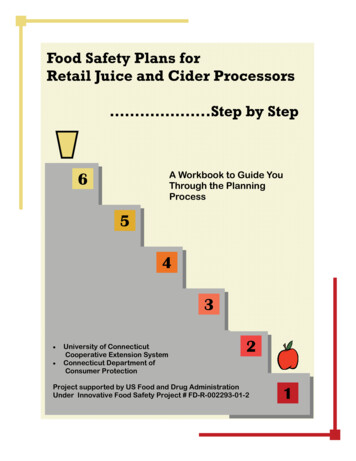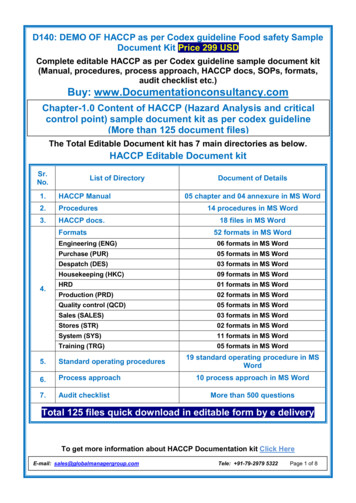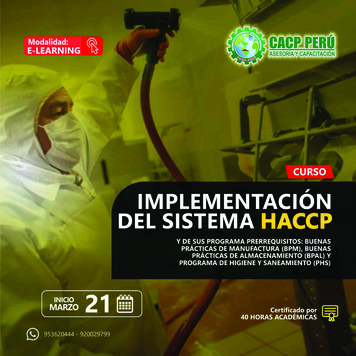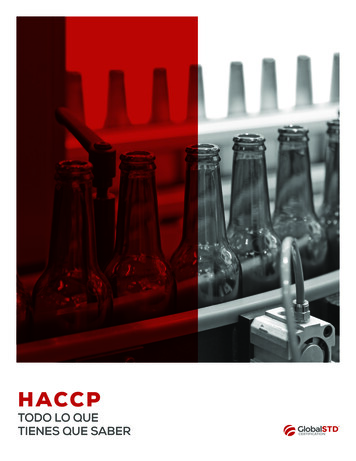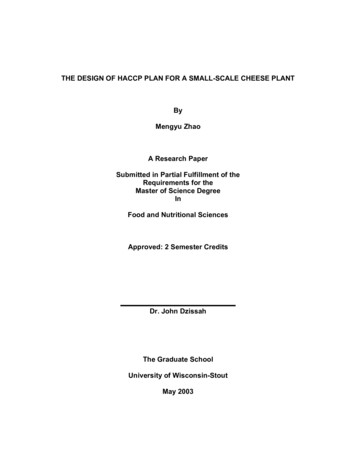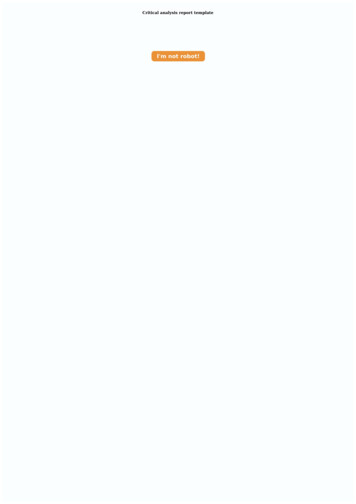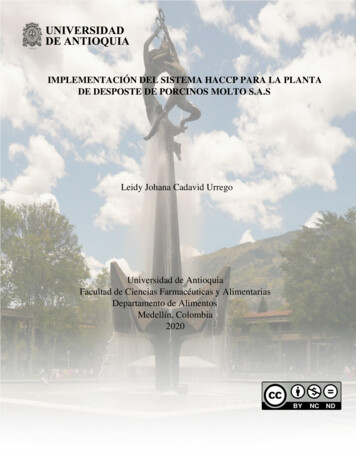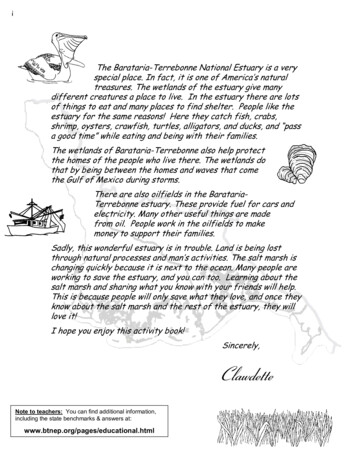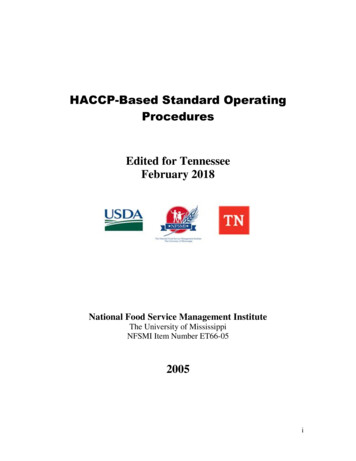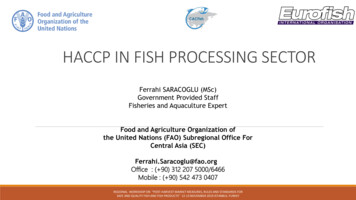
Transcription
HACCP IN FISH PROCESSING SECTORFerrahi SARACOGLU (MSc)Government Provided StaffFisheries and Aquaculture ExpertFood and Agriculture Organization ofthe United Nations (FAO) Subregional Office ForCentral Asia (SEC)Ferrahi.Saracoglu@fao.orgOffice : ( 90) 312 207 5000/6466Mobile : ( 90) 542 473 0407REGIONAL WORKSHOP ON “POST-HARVEST MARKET MEASURES, RULES AND STANDARDS FORSAFE AND QUALITY FISH AND FISH PRODUCTS” 12-13 NOVEMBER 2019 ISTANBUL-TURKEY
Outline IntroductionWhat is the HACCP System?HistoryWhy we need HACCP in Fish ProcessesWhat is the hazardsHACCP PrinciplesHACCP Implementation to The Fish ProcessesPrerequisite ProgramsREGIONAL WORKSHOP ON “POST-HARVEST MARKET MEASURES, RULES AND STANDARDS FORSAFE AND QUALITY FISH AND FISH PRODUCTS” 12-13 NOVEMBER 2019 ISTANBUL-TURKEY
Introduction According to data published in 2015 by FAO, 17 percent of the world supply of animal proteinsderived from Fish. With capture fishery production relatively static since the late 1980s, aquaculture has beenresponsible for the continuing impressive growth in the supply of fish for human consumption. In per capita terms, food fish consumption grew from 9.0 kg in 1961 to 20.2 kg in 2015, at anaverage rate of about 1.5 percent per year. The highest per capita fish consumption, over 50 kg, is found in several small island developingStates (SIDS), particularly in Oceania, while the lowest levels, just above 2 kg, are in Central Asiaand Caucasus Fish is an exceptionally important component of the human diet and an enormous industryexists to provide a huge variety of consumer products in which fish is a major component.REGIONAL WORKSHOP ON “POST-HARVEST MARKET MEASURES, RULES AND STANDARDS FORSAFE AND QUALITY FISH AND FISH PRODUCTS” 12-13 NOVEMBER 2019 ISTANBUL-TURKEY
What Is The MENTBASEDSYSTEMATICFULLYDOCUMENTEDREGIONAL WORKSHOP ON “POST-HARVEST MARKET MEASURES, RULES AND STANDARDS FORSAFE AND QUALITY FISH AND FISH PRODUCTS” 12-13 NOVEMBER 2019 ISTANBUL-TURKEY
Food Safety And Quality PyramidTrainingEducationContinuousQuality ImprovementHACCPPrerequisite ProgramsManagement CommitmentREGIONAL WORKSHOP ON “POST-HARVEST MARKET MEASURES, RULES AND STANDARDS FORSAFE AND QUALITY FISH AND FISH PRODUCTS” 12-13 NOVEMBER 2019 ISTANBUL-TURKEY
History1971: HACCP Presentedat 1th National FoodSafety Conference195019601951: Dr Deming and othersdeveloped total qualitymanagement (TQM) systems19701980:WHO/ICMSFPublished areport onHACCP1997: FDA issued its finalrule to mandate HACCPfor use in seafoodprocessing plants.19801974: A regulation for low acid cannedfood was published by FDA and HACCPbecame mandatory.1961: NASA and Pillsburyfirst developed HACCP(3 Principles)1983: WHO Europerecommended HACCP200019901985: NationalAcademy ofSciencerecommendedHACCP1992: NACMCFissues a reviseddocuments, Thefirst documentwith 7 principlesof HACCP.1986: FAO FisheryIndustries Division(FAO/FII) adopted theHACCP approach tofish qualityassessmentREGIONAL WORKSHOP ON “POST-HARVEST MARKET MEASURES, RULES AND STANDARDS FORSAFE AND QUALITY FISH AND FISH PRODUCTS” 12-13 NOVEMBER 2019 ISTANBUL-TURKEY1994: HACCP wasintroduced into EULegislation.1993: Codex AlimentariusComission published firstguideliness2005: ISO 22000 FoodSafety ManagementSystem formed.1995: FDA NACMCFissues a reviseddocuments, The firstdocument with 7principles of HACCP.
Why We Need eTime ConsumingHealthyRiskyREGIONAL WORKSHOP ON “POST-HARVEST MARKET MEASURES, RULES AND STANDARDS FORSAFE AND QUALITY FISH AND FISH PRODUCTS” 12-13 NOVEMBER 2019 ISTANBUL-TURKEY
Advantages Of The HACCP It focuses on those critical points in food processing and handling required for safe foodproduction Science based and systematic allowing for the specific identification of food safety hazards Requires the implementation of measures to control these hazards where significant Employs the principle of risk assessment allowing prevention to be based on the controlprogram rather than inspection and testing Better use of resources Standardization of hazard management allowing for easier auditing and inspection by secondand third partiesREGIONAL WORKSHOP ON “POST-HARVEST MARKET MEASURES, RULES AND STANDARDS FORSAFE AND QUALITY FISH AND FISH PRODUCTS” 12-13 NOVEMBER 2019 ISTANBUL-TURKEY
HACCP Implementations In Fish ProcessingPreliminary Processing Of ngScalingWashingMeat-BoneSeperatingREGIONAL WORKSHOP ON “POST-HARVEST MARKET MEASURES, RULES AND STANDARDS FORSAFE AND QUALITY FISH AND FISH PRODUCTS” 12-13 NOVEMBER 2019 ISTANBUL-TURKEY
Implementation Steps of HACCPREGIONAL WORKSHOP ON “POST-HARVEST MARKET MEASURES, RULES AND STANDARDS FORSAFE AND QUALITY FISH AND FISH PRODUCTS” 12-13 NOVEMBER 2019 ISTANBUL-TURKEY
Step 1: Assemble HACCP Team Gather as many materials and documents related tofood safety as well as assemble a team to representdifferent sectors within the industry. One HACCP coordinator with HACCP skills should bechosen. The team should represent engineering, production,sanitation, and quality assurance. Larger companies can have teams of seven or eightpeople while small companies may have teams as smallas two or three people. The HACCP coordinator should have responsibility forthe whole HACCP program and be the team leader Obtain management commitmentREGIONAL WORKSHOP ON “POST-HARVEST MARKET MEASURES, RULES AND STANDARDS FORSAFE AND QUALITY FISH AND FISH PRODUCTS” 12-13 NOVEMBER 2019 ISTANBUL-TURKEY
Step 2:Describe Product Product name (common name) or group of product names (thegrouping of like products is acceptable as long as all hazards areaddressed) Important end-product characteristics: properties or characteristicsof the food under review that are required to ensure its safety (e.g.pH/preservatives) How the product is to be used (i.e. ready-to-eat/further processingrequired, heated prior to consumption) Type of package, including packaging material and packagingconditions (e.g. modified atmosphere) Shelf-life, including storage temperature and humidity if applicable Where the product will be sold (e.g. retail, institutions, furtherprocessing) Labelling instructions (e.g. handling and usage instructions) Special distribution control (e.g. shipping conditions)REGIONAL WORKSHOP ON “POST-HARVEST MARKET MEASURES, RULES AND STANDARDS FORSAFE AND QUALITY FISH AND FISH PRODUCTS” 12-13 NOVEMBER 2019 ISTANBUL-TURKEY
Step 3: Identify Intended Use Describe the normal expected use of the food Who are the customers? Who might misuse or abuse the product? Ensure clear instructions on the label.REGIONAL WORKSHOP ON “POST-HARVEST MARKET MEASURES, RULES AND STANDARDS FORSAFE AND QUALITY FISH AND FISH PRODUCTS” 12-13 NOVEMBER 2019 ISTANBUL-TURKEY
Step 4: Construct Flow Diagram A flow diagram is a graphical representation of theprocess steps involved in making the food productand is developed by the HACCP team. It should becomprehensive and cover all the steps in theprocesses and the defined scope of the HACCP study.REGIONAL WORKSHOP ON “POST-HARVEST MARKET MEASURES, RULES AND STANDARDS FORSAFE AND QUALITY FISH AND FISH PRODUCTS” 12-13 NOVEMBER 2019 ISTANBUL-TURKEY
Fresh Fish Flow Diagram ExampleReceiving*Storage*Wash* Denotes that one or more CCPs havebeen GIONAL WORKSHOP ON “POST-HARVEST MARKET MEASURES, RULES AND STANDARDS FORSAFE AND QUALITY FISH AND FISH PRODUCTS” 12-13 NOVEMBER 2019 ISTANBUL-TURKEY
Step 5: Verification of Flow Diagram After the flow diagram has been drawnup, the multidisciplinary team shouldconfirm it on site during operating hours. Any observed deviation must result in anamendment of the original flow diagramto make it accurate.REGIONAL WORKSHOP ON “POST-HARVEST MARKET MEASURES, RULES AND STANDARDS FORSAFE AND QUALITY FISH AND FISH PRODUCTS” 12-13 NOVEMBER 2019 ISTANBUL-TURKEY
7 Principles of HACCPConduct A HazardAnalysis1Determine TheCritical ControlPoints (CCPs)2Establish lishCorrective Actions5Establish Record keepingand DocumentationProcedures7REGIONAL WORKSHOP ON “POST-HARVEST MARKET MEASURES, RULES AND STANDARDS FORSAFE AND QUALITY FISH AND FISH PRODUCTS” 12-13 NOVEMBER 2019 ISTANBUL-TURKEYEstablishVerificationProcedures6
Step 6: Conduct a Hazard Analysis-Principle 1 List all potential hazards associated with each step Conduct a hazard analysis Determine whether there are hazards that arereasonably likely to occur Identify preventive measures to control theidentified hazardsREGIONAL WORKSHOP ON “POST-HARVEST MARKET MEASURES, RULES AND STANDARDS FORSAFE AND QUALITY FISH AND FISH PRODUCTS” 12-13 NOVEMBER 2019 ISTANBUL-TURKEY
Potential HazardsHazard: A biological, chemical or physical agent in, or condition of,food with a potential to cause an adverse health effect (Codex,2009b)AgentsAdverse Health Effects Bacteria Viruses Moulds Parasites Toxins Chemicals & Allergens Foreign materialChokingVomitingFeverKrampsChronic InfectionsDamage of OrgansCancerDeathREGIONAL WORKSHOP ON “POST-HARVEST MARKET MEASURES, RULES AND STANDARDS FORSAFE AND QUALITY FISH AND FISH PRODUCTS” 12-13 NOVEMBER 2019 ISTANBUL-TURKEY
Biological Hazards Foodborne biological hazards include microbiological organismssuch as bacteria, viruses, fungi and parasites. These organisms are commonly associated with humans andwith raw products entering the food establishment. Many of-these microorganisms occur naturally in theenvironment where foods are grown. Most are killed or inactivated by cooking, and numbers can beminimized by adequate control of handling and storage practices(hygiene, temperature and time)REGIONAL WORKSHOP ON “POST-HARVEST MARKET MEASURES, RULES AND STANDARDS FORSAFE AND QUALITY FISH AND FISH PRODUCTS” 12-13 NOVEMBER 2019 ISTANBUL-TURKEY
Chemical Hazards Inorganic chemicals: arsenic, cadmium, lead,mercury, selenium, sulphites (used in shrimpprocessing) Organic compounds: polychlorinated biphenyls,dioxins, insecticides (chlorinated hydrocarbons). Thisis a very diverse group with a wide range of industrialusers. Unfortunately the chemical stability allow themto accumulate and persist in the environment Processing related compounds: nitrosamines andcontaminants related to aquaculture (antibiotics,hormones).REGIONAL WORKSHOP ON “POST-HARVEST MARKET MEASURES, RULES AND STANDARDS FORSAFE AND QUALITY FISH AND FISH PRODUCTS” 12-13 NOVEMBER 2019 ISTANBUL-TURKEY
Physical Hazards Physical hazards include any potentiallyharmful extraneous matter not normallyfound in food. The extraneous matter found infish products can be divided or classified as:Non-food safety hazards (e.g. filth)Food safety hazards (e.g. glass, metal, wood,bones, stones, hard plastic).REGIONAL WORKSHOP ON “POST-HARVEST MARKET MEASURES, RULES AND STANDARDS FORSAFE AND QUALITY FISH AND FISH PRODUCTS” 12-13 NOVEMBER 2019 ISTANBUL-TURKEY
Step 7: Determine Critical Control Points-Principle 2 The Codex guidelines define a critical control point (CCP) as "a step at which control canbe applied and is essential to prevent or eliminate a food safety hazard or reduce it to anacceptable level". The determination of a CCP in the HACCP system can be facilitated by the application ofa decision tree such as that included in the Codex Hazard Analysis and Critical ControlPoint (HACCP) sys-tem and guidelines for its application which indicates a logicalreasoning approach. The application of the decision tree should be flexible according to the type of operation(production, slaughter, processing, storage, distribution or other).REGIONAL WORKSHOP ON “POST-HARVEST MARKET MEASURES, RULES AND STANDARDS FORSAFE AND QUALITY FISH AND FISH PRODUCTS” 12-13 NOVEMBER 2019 ISTANBUL-TURKEY
Decision TreeREGIONAL WORKSHOP ON “POST-HARVEST MARKET MEASURES, RULES AND STANDARDS FORSAFE AND QUALITY FISH AND FISH PRODUCTS” 12-13 NOVEMBER 2019 ISTANBUL-TURKEY
Step 8: Establish Critical Limits For Each CCPPrinciple 3 Critical Limit is a criterion which separates acceptability from unacceptability. Critical limits are criteria, which must be met if control is to be achieved. These are based onexperience, regulations, literature searches, microbiological data, etc. Targets set at each critical control point which guarantees to eliminate or reduce the hazard to asafe level Critical limits can be values of : pH, temperature, time, Maximum residue limits, Maximumlevels (of contaminants), Limits in microbiological criteria, Level of cleanliness, Levels of chlorine,overpressure etc.REGIONAL WORKSHOP ON “POST-HARVEST MARKET MEASURES, RULES AND STANDARDS FORSAFE AND QUALITY FISH AND FISH PRODUCTS” 12-13 NOVEMBER 2019 ISTANBUL-TURKEY
Step 9 : Establish a Monitoring System For Each CCPPrinciple 4 The Codex Hazard Analysis and Critical Control Point (HACCP)system and guidelines for its application defines monitoring as"the act of conducting a planned sequence of observations ormeasurements of control parameters to assess whether a CCPis under control". To measure the performance level of the system's operation atthe CCP (trend analysis) To determine when the performance level of the system resultsin a loss of control at the CCP, e.g. when there is deviation froma critical limit To establish records that reflect the performance level of thesystem's operation at the CCP to comply with the HACCP planREGIONAL WORKSHOP ON “POST-HARVEST MARKET MEASURES, RULES AND STANDARDS FORSAFE AND QUALITY FISH AND FISH PRODUCTS” 12-13 NOVEMBER 2019 ISTANBUL-TURKEY
Monitoring Document ExampleStep: Product and Refrigerated StorageFRESH FISHCritical ControlMonitoring StepPointMonitoringFrequencyCritical LimitsAction on DeviationStorage TemperatureVerify required storage temperature is met.Prior to productionstart and in afternoonMaintain products between 0 0C and3 0CWhen internal temperature exceeds 3 0C,product is culled by a supervisor fordecompositionMultiple Use ofStorage AreaConfirm Processed and raw fish are separated by adivider.Confirm that no chemicals or cleaners are in storage unit.DailyNo mixing processed and raw fishproducts.No chemicals or cleaners in storageunit.Confirm if stored product iscontaminated and cull as required.Remove chemical/cleaners. Checkproduct for contamination.Product InspectionInspect each lot for decomposition and requiredidentification.Confirm proper icing of unprocessed fish.Each Monday andThursdayEach lot to be adequately identified(receipt date or production date andsource).All unprocessed fish to be layeredand covered with ice.Assign lot identity.Re-ice products when required.Rotation of StockAll product is checked determine length or storage.Confirm stock (raw and finished) is rotated on a first –infirst- out basic.WeeklyUse dressed fish for productionwithin 5 days.Ship finished product within 3 days.Rotation system is adhered to.Ensure passed product is immediatelyprocessed or shipped.Modify rotation system.Notify supplier for all noted deviations.All corrective actions to be recorded andsigned by supervisor.REGIONAL WORKSHOP ON “POST-HARVEST MARKET MEASURES, RULES AND STANDARDS FORSAFE AND QUALITY FISH AND FISH PRODUCTS” 12-13 NOVEMBER 2019 ISTANBUL-TURKEY
Step 10 : Establish Corrective Actions- Principle 5 The Codex Hazard Analysis and Critical Control Point (HACCP) system and guidelines for itsapplication defines corrective action as "any action to be taken when the results of monitoringat the CCP indicate a loss of control". For each CCP, corrective actions have to be planned in advance by the HACCP team, so that theycan be taken without hesitation when monitoring indicates a deviation from the critical limit. Corrective actions should ensure that only safe products reach the consumer Actions to be taken when the results of monitoring at the CCP indicate a loss of control Corrective action procedure include; deviation, identification deviation, isolated of affectedproducts, evaluation of affected products and all procedure records.REGIONAL WORKSHOP ON “POST-HARVEST MARKET MEASURES, RULES AND STANDARDS FORSAFE AND QUALITY FISH AND FISH PRODUCTS” 12-13 NOVEMBER 2019 ISTANBUL-TURKEY
Step 11 : Establish Verification Procedure –Principle 6 Verification procedures are intended to check the effectiveness of the HACCP system The HACCP team should specify the methods and procedures to be used for determining if theHACCP is working correctly. Methods for verification may include in particular: random sampling and analysisreinforced analysis or tests at selected critical pointsintensified analysis of intermediate or final productssurveys on actual condition during storage, distribution and sale and on actual use of the product Verification procedures include; HACCP plan validation HACCP system audits Equipment calibrationREGIONAL WORKSHOP ON “POST-HARVEST MARKET MEASURES, RULES AND STANDARDS FORSAFE AND QUALITY FISH AND FISH PRODUCTS” 12-13 NOVEMBER 2019 ISTANBUL-TURKEY
Example Verification ProceduresVerification ProceduresMinimum FrequencyVerification scheduleAnnuallyPrerequisite program verificationIn the beginning and annually thereafterValidation of critical limits and HACCP systemBefore and during HACCP system implementationRevalidation of HACCP planAnnually or upon significant changeObservation and interview of CCP monitorQuarterly/monitor/CCPCCP monitoring record reviewDailyEquipment calibrationAccording to HACCP planOthers records reviewMonthlyHACCP system verificationAnnuallyREGIONAL WORKSHOP ON “POST-HARVEST MARKET MEASURES, RULES AND STANDARDS FORSAFE AND QUALITY FISH AND FISH PRODUCTS” 12-13 NOVEMBER 2019 ISTANBUL-TURKEY
Step 12: Establish Documentation and RecordKeeping – Principle 7 Four types of records should be kept as part of the HACCP programme: Support documentation for developing the HACCP planRecords generated by the HACCP systemDocumentation of methods and procedures usedRecords of employee training programmes HACCP system records are kept to demonstrate adherence of the HACCP system with the HACCPplan. These records are used to demonstrate control at CCPs in the food process. The recordsgenerated by the HACCP system include all activities and documentation required by the plan, asfollows. Monitoring records for all CCPsDeviation and corrective action recordsVerification/validation recordsTraining recordsREGIONAL WORKSHOP ON “POST-HARVEST MARKET MEASURES, RULES AND STANDARDS FORSAFE AND QUALITY FISH AND FISH PRODUCTS” 12-13 NOVEMBER 2019 ISTANBUL-TURKEY
Step 12: Establish Documentation and RecordKeeping – Principle 7 Efficient and accurate record keeping is essential to the application of a HACCP system. HACCPprocedures should be documented. Documentation and record keeping should be appropriateto the nature and size of the operation. Documentation examples are: Parasite Control Form Packaging Control Form Metal Dedector Control Form Record examples are: CCP monitoring activities; Deviations and associated corrective actions; Modifications to the HACCP systemREGIONAL WORKSHOP ON “POST-HARVEST MARKET MEASURES, RULES AND STANDARDS FORSAFE AND QUALITY FISH AND FISH PRODUCTS” 12-13 NOVEMBER 2019 ISTANBUL-TURKEY
Prerequisite ProgramsPrerequisite Program: A programme that is required prior to the application of the HACCPsystem to ensure that a fish and shellfish processing facility is operating according to the CodexPrinciples of Food Hygiene, the appropriate Code of Practice and appropriate food safetylegislation.REGIONAL WORKSHOP ON “POST-HARVEST MARKET MEASURES, RULES AND STANDARDS FORSAFE AND QUALITY FISH AND FISH PRODUCTS” 12-13 NOVEMBER 2019 ISTANBUL-TURKEY
Prerequisite Programs The application of HACCP does not stand alone in a food processing facility. The plan must bebuilt on other food safety programs. Sanitation standard operating procedures (SSOPs) Good Manufacturing Practices (GMP)SanitationPersonal hygieneEmployee trainingRecall procedureSupplier ControlChemical ControlReceiving, Storage and ShippingPest controlREGIONAL WORKSHOP ON “POST-HARVEST MARKET MEASURES, RULES AND STANDARDS FORSAFE AND QUALITY FISH AND FISH PRODUCTS” 12-13 NOVEMBER 2019 ISTANBUL-TURKEY
REGIONAL WORKSHOP ON “POST-HARVEST MARKET MEASURES, RULES AND STANDARDS FORSAFE AND QUALITY FISH AND FISH PRODUCTS” 12-13 NOVEMBER 2019 ISTANBUL-TURKEY
REGIONAL WORKSHOP ON "POST-HARVEST MARKET MEASURES, RULES AND STANDARDS FOR SAFE AND QUALITY FISH AND FISH PRODUCTS" 12-13 NOVEMBER 2019 ISTANBUL-TURKEY 1950 1951: Dr Deming and others developed total quality management (TQM) systems 1960 1970 1980 1990 2000 1961: NASA and Pillsbury first developed HACCP (3 Principles) 1971: HACCP Presented
